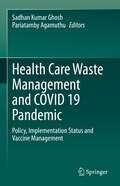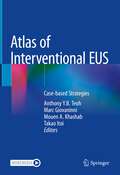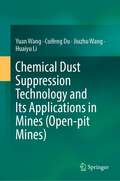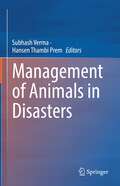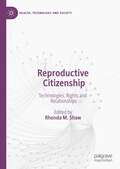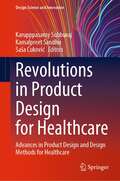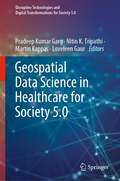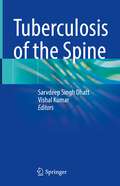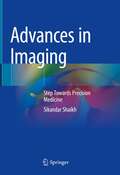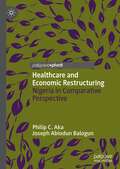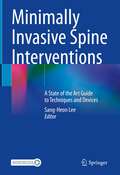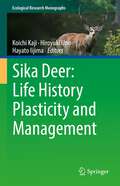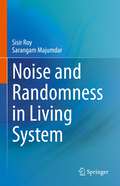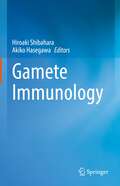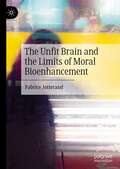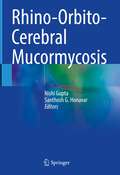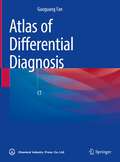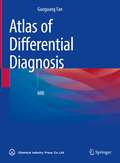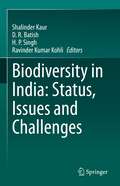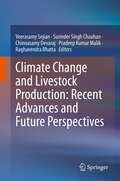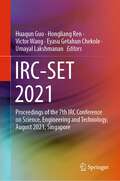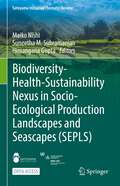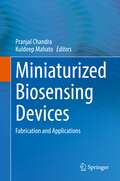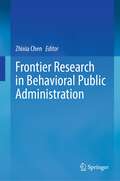- Table View
- List View
Health Care Waste Management and COVID 19 Pandemic: Policy, Implementation Status and Vaccine Management
by Sadhan Kumar Ghosh Pariatamby AgamuthuThis book deals with the general principles, policy instruments, sustainability of supply chain, and business of health-care waste (HCW) management including inputs on exercise in immune health defense against COVID 19. Health-care waste management is very important in any country for protection of environmental and animal and human health. The COVID-19 pandemic, in addition, has augmented this importance to a greater extent. Italy has been successful in curbing the problems related to HCW management during the COVID-19 pandemic at very fast rates from the worst situation, while for a few countries in Asia and Africa, challenges still exist. It is necessary that policy makers, researchers, and implementers gain more knowledge and information on these aspects and improve the strategies and actions. Addressing these issues will reduce the cost of health care as well as resource inefficiency hindering sustainable development goals. This book is of interest and useful to practitioners, capacity builders and policy makers, entrepreneurs, NGOs, and general people, and is a valuable source of reference to the relevant researchers and students in global markets. The book serves as a reading material for undergraduate and graduate students of environmental science, waste management, and medical science. National and international scientists as well as policy makers will also find this to be a useful read.
Atlas of Interventional EUS: Case-based Strategies
by Anthony Y. B. Teoh Marc Giovaninni Mouen A. Khashab Takao ItoiThis atlas aims to systematically provide a case-by-case discussion on selected interventional endoscopic ultrasonography (EUS) procedures and how to approach such procedures on different patients. The atlas offers illustrations of the interventional procedures and several cases of the procedures are included. Within each case, a standardized report is provided including a brief history, imaging findings, a detailed discussion on treatment options, considerations in the EUS intervention, how to perform the procedures and final outcomes. EUS-guided drainages of the bile duct, pancreatic duct, gallbladder and abscesses are summarized. Ablative procedures including celiac plexus, pancreatic cyst and radiofrequency ablations are also covered. Other procedures guided by EUS, including gastroenterostomy, injected therapy, iodine beads insertion and fiducial marker insertion and endovascular interventions are further demonstrated. Gastroenterologists and surgeons can benefit from this atlas on learning strategies and preparing for these procedures.
Chemical Dust Suppression Technology and Its Applications in Mines (Open-pit Mines)
by Yuan Wang Cuifeng Du Jiuzhu Wang Huaiyu LiThis book focuses on the study of chemical dust suppression in mine dust pollution control by means of theories, experiments, computer simulation, and case application, aiming at providing chemical dust suppression solutions for mining worksites. It has seven chapters, including the following contents: (1) introduces fundamental theories and applications of chemical dust suppression, analyzes the dust source intensity of worksites and the mechanisms of dust generation, and summarizes the dust control measures for different mining worksites. (2) According to the mechanisms of dust generation in different mining worksites, targeted dust suppressants were developed. Through optimization by monomer experiment and orthogonal experiment, the optimum formula of different types of dust suppressants was obtained, and its properties were characterized. (3) The dust suppressant field application process was introduced, and the economic benefits were analyzed. This book is expected to provide valuable references both for researchers and engineering technicians engaged in environmental engineering, safety engineering, occupational health, and mining metallurgical engineering, and it also serves as a textbook for graduate students in above disciplines.
Management of Animals in Disasters
by Subhash Verma Hansen Thambi PremThis book is a comprehensive guide for veterinary and humanitarian professionals to plan emergency responses for the care and welfare of animals. It covers various topics on disasters, such as principles of disaster management, operation planning, team deployment, etc., from the perspective of saving both livestock and the livelihood of vulnerable communities. The book also discusses the importance of early warning systems, biosecurity, techniques for data collection, one health approach, climate change, and appropriate mitigation strategies. It highlights different principles, approaches, and guidelines related to the rescue, relief, and management of animals during disasters. It also contains topics on the welfare of birds and the rescue and relief of wild animals. This book includes essential veterinary and life-saving supplies required by the relief providing teams during emergencies such as disasters. The book helps administrators understand the key aspects of welfare and management of animals during disasters and enable them to draft policies focusing on humans and animals’ rescue & welfare and protection of livelihoods. It is an essential guide for veterinarians, humanitarian workers, field functionaries, farmers, disaster response forces personnel, etc., during various types of disasters and emergencies.
Reproductive Citizenship: Technologies, Rights and Relationships (Health, Technology and Society)
by Rhonda M. ShawThis book addresses responses to the predicament of medical and social infertility. It draws on international research to examine the dimensions of reproductive citizenship in relation to decision-making about a range of issues: from fertility preservation and the desirability of family creation as a normative expectation of social participation, to how families manage and negotiate engagement with providers of reproductive materials and services around information disclosure and contact, and how they consider their social obligations and responsibilities in relation to the use of assisted reproductive technology (ART).
Revolutions in Product Design for Healthcare: Advances in Product Design and Design Methods for Healthcare (Design Science and Innovation)
by Karupppasamy Subburaj Kamalpreet Sandhu Saša ĆukovićThis book coherently presents advances in design principles, processes, and methods in healthcare product design. It captures the implications of technological advances on designing healthcare products especially when market and societal needs pull each other in opposite directions. The contents focus on innovative design thinking processes and methods in developing healthcare products, applications of digital technologies in healthcare product design, amalgamation of artificial intelligence and design thinking for healthcare product design and quality, sustainability, and regulatory aspects in the design process. This book is a useful reference for those in the industry and academia.
Geospatial Data Science in Healthcare for Society 5.0 (Disruptive Technologies and Digital Transformations for Society 5.0)
by Pradeep Kumar Garg Nitin K. Tripathi Martin Kappas Loveleen GaurThe book introduces a variety of latest techniques designed to represent, enhance, and empower multi-disciplinary approaches of geographic information system (GIS), artificial intelligence (AI), deep learning (DL), machine learning, and cloud computing research in healthcare. It provides a unique compendium of the current and emerging use of geospatial data for healthcare and reflects the diversity, complexity, and depth and breadth of this multi-disciplinary area. This book addresses various aspects of how smart healthcare devices can be used to detect and analyze diseases. Further, it describes various tools and techniques to evaluate the efficacy, suitability, and efficiency of geospatial data for health-related applications. It features illustrative case studies, including future applications and healthcare challenges. This book is beneficial for computer science and engineering students and researchers, medical professionals, and anyone interested in using geospatial data in healthcare. It is also intended for experts, offering them a valuable retrospective and a global vision for the future, as well as for non-experts who are curious to learn about this important subject. The book presents an effort to draw how we can build health-related applications using geospatial big data and their subsequent analysis.
Tuberculosis of the Spine
by Sarvdeep Singh Dhatt Vishal KumarThis book covers all aspects and dimensions of tuberculosis affecting the spine, starting from its historical perspective to modern trends in early diagnosis, management, and rehabilitation. This book is a treatise fulfilling all the existing wide lacunae in suspicion, clinical examination, diagnosis, and management of this disease which still dwells as a mystery in modern medicine. It presents very easy to follow management plan algorithms and keynotes for easy and ready reference in each chapter. It describes the recent advances in diagnostic modalities and the treatment regimes, along with controversies, that have been elucidated and concluded with firm and sound references from evidence-based literature. This book also showcases the varied presentations of the disease as per varied socio-economic strata and in different geographic regions along with the different, principle-based approach to the disease spectrum shall be discussed at length. It also includes different clinical settings and scenarios in the concerned chapters. This book is a ready reference guide for postgraduate trainees, post-doctoral trainees, and faculty and consultants of orthopedics and neurosurgery.
Advances in Imaging: Step Towards Precision Medicine
by Sikandar ShaikhThis book covers all the advances in the imaging and elaborates on their applications and advantages. It provides step by step overview of the various advanced imaging modalities like molecular imaging, nano imaging, robotic imaging, stem cell imaging, optical imaging, immunoimaging, etc. It describes the applications of various advanced imaging modalities in pathologies like oncology, infection and inflammation and other conditions and provides the available therapeutic options with the help of these modalities. It also covers the detailed aspects of various modalities like ultrasound, CT, MRI, PET-CT, PET-MRI and other modalities. It includes the detailed explanation of various radiotracers, biomarkers and probes with many applications. Chapters cover detailed information at molecular level. The book is helpful for oncologists, hematologists, surgeons and many other specialists.
Healthcare and Economic Restructuring: Nigeria in Comparative Perspective
by Philip C. Aka Joseph Abiodun BalogunThis book explores the intersection between healthcare delivery and national economic health, using Nigeria as case study and window into the world. Specifically, the issue this book tackles revolves around how to repair Nigeria’s dysfunctional healthcare system through the medium of a healthier economy that provides sufficient revenue to meet the healthcare needs of citizens.
Minimally Invasive Spine Interventions: A State of the Art Guide to Techniques and Devices
by Sang-Heon LeeThis book is an up-to-date guide to the techniques and devices that may be used when performing minimally invasive spine interventions. The indications for such procedures, which offer various advantages over open surgery, continue to expand, and the aim of the book is to equip spine interventionists with the knowledge required in order to achieve optimal clinical outcomes consistently. After discussion of all aspects of patient preparation, conventional minimally invasive procedures for disorders of the cervical, thoracic, lumbar, and sacral spine are thoroughly reviewed. Attention then turns to more advanced techniques and devices, including percutaneous epidural neurolysis, foraminoplasty, the L’DISQ device for disc decompression, transforaminal epiduroscopic laser annuloplasty (TELA), trans-sacral endoscopic laser decompression (SELD), percutaneous endoscopic lumbar discectomy (PELD), and minimally invasive lumbar decompression (MILD). In addition to full description and illustration of treatment methods, guidance is provided on indications, contraindications, potential complications, and postoperative care.
Sika Deer: Life History Plasticity and Management (Ecological Research Monographs)
by Koichi Kaji Hiroyuki Uno Hayato IijimaThis book provides complete and up-to-date information on sika deer biology and its management, focusing on their life history with an integrated approach of population dynamics, morphology, genetics, and evolution. The expanding distribution of sika and its increase in population in Japan and other countries are causing damage to agriculture and forestry, impacting ecosystems and affecting other species. We are facing conflicting deer issues regarding the conservation of resource values and pest control of sika deer. This contributed volume compiles new findings focusing on the ecological plasticity of the sika deer. It aims to clarify the ecological characteristics of the deer by integrating studies of different approaches and provides a perspective for their management. The book consists of six parts. Part I introduces the ecological and management background behind the history of sika deer. The following four parts discuss movement ecology (Part II), impact on vegetation and bottom-up effect on sika deer (Part III), impact on ecosystem and its resilience (Part IV), and comparison of life-history characteristics between sika deer and other ungulate species (Part V). The last part (Part VI) covers the science-based management of sika deer. Contributed by recognized experts and young researchers of sika deer, this book appeals to researchers and professionals in wildlife biology and wildlife management, evolution, population dynamics, morphology, genetics, and reproductive physiology.
Noise and Randomness in Living System
by Sisir Roy Sarangam MajumdarThis book illustrates the role of randomness and noise in living organisms. Traditionally, the randomness and noise have been used in understanding signal processing in communications. This book is divided into two sections, the first of which introduces readers to the various types and sources of noise and the constructive role of noise in non-linear dynamics. It also analyses the importance of randomness and noise in a variety of science and engineering applications. In turn, the second section discusses in detail the functional role of noise in biological processes for example, in case of brain function at the level of ion channel, synaptic level and even at cognitive level. These are described in various chapters. One of the challenging issue finding the neuronal correlates of various meditative states is to understand how brain controls various types of noise so as to reach a state of synchronized oscillatory state of the brain corresponding to the state of Samadhi. This is described in details in one chapter called Noise, Coherence and meditation. The concept of noise and the role of randomness in living organism raise lot of controversy for last few decades. This is discussed in a separate chapter. Finally, the epistemic and ontic nature of randomness as discussed in physical science are investigated in the context of living organism.
Gamete Immunology
by Hiroaki Shibahara Akiko HasegawaThis book describes the biology, diagnosis, treatment and the latest research on anti-sperm antibody (ASA) and anti-zona pellucida antibody (AZPA) produced in some infertile patients. It summarizes ASA in both men and women, and presents new research to serve as a guideline for medical treatment, which currently varies considerably. It also discusses the recently identified target antigens of these antibodies, and the latest immunocontraceptive development projects. The book features chapters on AZPA explaining the biological structure and function of the zona pellucida, and describing the abnormality and the antibody. It also provides insights into their evolution, presenting the differences in taxonomy, mammalian physiological functions and the morphologically and immunologically unique human zona pellucida. Gamete Immunology is a valuable resource for researchers, and postdocs who are curious about new research on ASA and AZPA. It offers clinicians and embryologists who are interested in gamete immunology diverse perspectives as well as the basis for new ideas to treat the antibodies and develop contraceptive vaccinogens.
The Unfit Brain and the Limits of Moral Bioenhancement
by Fabrice JotterandIn light of the potential novel applications of neurotechnologies in psychiatry and the current debate on moral bioenhancement, this book outlines the reasons why more conceptual work is needed to inform the scientific and medical community, and society at large, about the implications of moral bioenhancement before a possible, highly hypothetical at this point, broad acceptance, and potential implementation in areas such as psychiatry (e.g., treatment of psychopathy), or as a measure to prevent crime in society. The author does not negate the possibility of altering or manipulating moral behavior through technological means. Rather he argues that the scope of interventions is limited because the various options available to “enhance morality” improve, or simply manipulate, some elements of moral behavior and not the moral agent per se in the various elements constitutive of moral agency. The concept of Identity Integrity is suggested as a potential framework for a responsible use of neurotechnologies in psychiatry to avoid human beings becoming orderers and orderables of technological manipulations.
Rhino-Orbito-Cerebral Mucormycosis
by Nishi Gupta Santhosh G. HonavarThis book is the most comprehensive (and possibly the first) manual on ‘Rhino-Orbito-Cerebral Mucormycosis (ROCM) that covers mucormycosis of the nose extending to sinuses, orbit, and brain, all in. This volume covers the surge of cases during the COVID-19 pandemic, early identification and causative factors, microbiology, pathology and radiology, and the clinical presentation. Notes on surgical approaches, extent, and techniques of debridement, number of sittings, antifungal therapy, complications, and their management equip readers to manage these cases confidently. Detailed descriptions of ROCM surgery accompanied by nearly 500 photographs and anatomical drawings help support diagnostic and surgical decision-making. Also included is information on various specifications of MRI that help in achieving a perfect surgical clearance. The book includes chapters on debates on salvaging the orbit in ROCM, various situations, their management, the extent of resection, antifungal dosage and duration, prognostication of the patient, and postoperative care. The book assists surgeons in gaining the skills to perform endoscopic clearance of difficult areas like pterygoplataine fossa, infratemporal fossa, pterygoid plates, and the lacrimal drainage system, which offers significant advantages in terms of avoiding postoperative morbidity as compared to an external route. Since the external route is required in the most extensive form of the disease, the book has also covered it extensively. This book is an indispensable resource for otorhinolaryngologists, ophthalmic surgeons, ophthalmic plastic surgeons, physicians, microbiologists, pathologists, radiologists, neurosurgeons, faciomaxillary surgeons and junior and senior consultants optometrists and students.
Atlas of Differential Diagnosis: CT
by Guoguang FanAiming to equip readers with the knowledge required for accurate and timely diagnosis, this book presents illustrative cases that address a broad spectrum of clinical problems, including frequent, uncommon and rare diseases of brain, head and neck, spine, musculoskeletal system, chest and abdomen. To make readers understand easily, tips in differential diagnosis are summarized in the table, accompanying with typical images and key teaching points. It will be a valuable resource for diagnostic radiologists, residents, fellows, and related clinical doctors.
Atlas of Differential Diagnosis: MRI
by Guoguang FanAiming to equip readers with the knowledge required for accurate and timely diagnosis, this book presents illustrative cases that address a broad spectrum of clinical problems, including frequent, uncommon and rare diseases of brain, head and neck, spine, musculoskeletal system, chest and abdomen. To make readers understand easily, tips in differential diagnosis are summarized in the table, accompanying with typical images and key teaching points. It will be a valuable resource for diagnostic radiologists, residents, fellows, and related clinical doctors.
Biodiversity in India: Status, Issues and Challenges
by Shalinder Kaur D. R. Batish H. P. Singh Ravinder Kumar KohliThis contributed book is based on the current status of biodiversity in India, issues and challenges faced by the authorities involved in conservation efforts, and the imperative role of various direct and indirect stakeholders in biodiversity conservation. The book discusses the current status of different forms of biodiversity in India, challenges faced by stakeholders, issues and reasons for biodiversity losses, and efforts by government through various laws, policies, and programs in a concise and comprehensive manner throughout its many chapters. In this way, readers can access diverse information on Indian biodiversity through this book. It is compiled by leading experts in the field of conservation. In 18 chapters, it covers biodiversity of both fauna and flora, on land and in aquatic ecosystems, legal and policy aspects, as well as innovative conservation tool and techniques. It is useful for undergraduates and graduate students and also educates policy planners, bureaucrats, foresters, and researchers in India and abroad.
Diabetic Foot Reconstruction: A Practical Guide
by Joon Pio Hong Hyunsuk SuhThis excellently illustrated book offers clear guidance on diabetic foot reconstruction based on a multidisciplinary and practical approach. In the past, the ulceration and necrosis associated with diabetic foot very frequently necessitated amputation. Now, microsurgical reconstruction of the diabetic foot, a procedure in which the author is an acknowledged expert, offers a means of saving the foot while also greatly improving long-term survival rates. The book covers all aspects of diabetic foot reconstruction with the aim of equipping readers with the knowledge required in order to achieve optimal outcomes. Preoperative evaluation is explained and full instruction provided on debridement, infection control, and vascular intervention – the key steps in preparing for a successful reconstruction. All stages in reconstruction are then described and illustrated, covering selection of the recipient vessel and flap, flap elevation, and microanastomosis. Guidance is also provided on toe and transmetatarsal amputation and surgical offloading procedures. Finally, the essentials of postoperative care are presented.
Climate Change and Livestock Production: Recent Advances and Future Perspectives
by Veerasamy Sejian Surinder Singh Chauhan Chinnasamy Devaraj Pradeep Kumar Malik Raghavendra BhattaThis book describes the importance of sustainable livestock production from a food security perspective in the changing climate scenario. It covers the amelioration of climate change impacts and describes the various mitigation strategies to reduce enteric methane emissions. The book targets sustainable livestock production by covering diverse concepts of amelioration, mitigation, and policy up-gradation. Further, it examines various adverse impacts of climate change on growth, meat, milk, and reproduction in livestock. Most importantly, the book covers novel aspects of quantifying heat stress response of livestock based on non-invasive methodologies, including infrared thermal imaging, sensor-based applications, hair, urine, and fecal cortisol estimation. Particular emphasis was given to describing the skin-based novel approaches to establish climate resilience in indigenous breeds. The book provides detailed descriptions of alleviating climate change impacts on shelter management, nutritional interventions, and genetics-based strategies involving advanced genomic tools. Lastly, it highlights the livestock species which could be considered ideal climate-resilient animal models to withstand the adversities associated with climate change.
IRC-SET 2021: Proceedings of the 7th IRC Conference on Science, Engineering and Technology, August 2021, Singapore
by Huaqun Guo Hongliang Ren Victor Wang Eyasu Getahun Chekole Umayal LakshmananThis book highlights contemporary state of research in multidisciplinary areas in computer science, computer engineering, chemical engineering, mechanical engineering, physics, biomedical sciences, life sciences, medicine, and health care. The accepted submissions to the 7th IRC Conference on Science, Engineering and Technology (IRC-SET 2021) that were presented on August 7, 2021, are published in this conference proceedings. The papers presented here were shortlisted after extensive rounds of rigorous reviews by a panel of esteemed individuals who are pioneers and experts in their respective domains.
Biodiversity-Health-Sustainability Nexus in Socio-Ecological Production Landscapes and Seascapes (Satoyama Initiative Thematic Review)
by Maiko Nishi Suneetha M. Subramanian Himangana GuptaThis is an open access book. It is a compilation of case studies that provide useful knowledge and lessons that derive from on-the-ground activities and contribute to policy recommendations, focusing on the interlinkages between biodiversity and multiple dimensions of health (e.g., physical, mental, and spiritual) in managing socio-ecological production landscapes and seascapes (SEPLS). This book provides insights on how SEPLS approaches can contribute to more sustainable management of natural resources, achieving global biodiversity and sustainable development goals, and good health for all. It is also expected to offer useful knowledge and information for an upcoming three-year thematic assessment of “the interlinkages among biodiversity, water, food, and health” (the so-called “nexus assessment”) by the Intergovernmental Science-Policy Platform on Biodiversity and Ecosystem Services (IPBES). The book begins with an introductory chapter followed by eleven case study chapters demonstrating the nexus between biodiversity, health, and sustainable development, and then a synthesis chapter clarifying the relevance of the case study findings to policy and academic discussions. It will be of interest to scholars, policymakers, and professionals in the field related to sustainable development.
Miniaturized Biosensing Devices: Fabrication and Applications
by Pranjal Chandra Kuldeep MahatoThis book presents tools and techniques for the development of miniature biosensors and their applications. The initial chapters discuss the advancements in the development of the transduction techniques, including optical, electrochemical, and piezoelectric, which are used for miniaturized biosensors. The book also reviews several technologies, such as nanotechnology, nanobiotechnology, immune-technology, DNA-technology, micro-manufacturing technology, electronic-circuit technology to increase the miniaturization and sensitivity of the biosensor platform. Subsequently, the chapters illustrate the applications of miniaturized biosensing systems in point-of-care monitoring of treatment and disease progression, environmental monitoring, food control, drug discovery, forensics, and biomedical research. Towards the end, the book discusses the advanced applications of biosensors in water quality monitoring, especially on-line detection systems and on-site detection of pesticides, heavy metals and bacteria in water. This book is an invaluable source for scientists working in biochemical engineering, bioengineering, and biomedical engineering in academia and industry.
Frontier Research in Behavioral Public Administration
by Zhixia ChenThis book mainly summarizes and analyzes the advanced research progress in the field of behavioral public administration, and also looks forward to the future of related academic research. It helps readers to quickly grasp the frontiers and latest developments in the field of behavioral public administration. It is benefit for readers to learn the hot topics, issues, and research methods, improving their research ability. It not only includes the frontier progress in western culture but also includes the researches in China.
